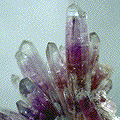 FEBRUARY BIRTHSTONE - AMETHYST
FEBRUARY BIRTHSTONE - AMETHYST
The gemstone Amethyst is the Birthstone
for February.
It is also the Zodiac stone for the
constellation of Pisces.
Amethyst is associated with spirituality, wisdom, sobriety, and security.Amethyst is the purple variety of the mineral quartz and is a popular gemstone.
Although it must always be purple to
be amethyst, it can and does have a wide range of purple shades. Its color is
unparalleled, and even other, more expensive purple gemstones are often compared
to its color and beauty. If it were not for its widespread availability, amethyst would
be very expensive.
The name "amethyst" comes from the
Greek and means "not drunken." This was perhaps due to a
belief that amethyst would ward off the effects of alcohol, but most
likely the Greeks were referring to the almost wine-like color
of some stones that they may have encountered.
Amethyst can occur as long prismatic crystals that
have a six sided pyramid at either end or can form as druzes that
are crystalline crusts that only show the pointed terminations. As
a mineral specimen, amethyst is popular for its color and nice
crystal shapes that produce a handsome, purple, sparkling cluster.
However, amethyst is not the same everywhere. Different localities
can produce a unique amethyst to that particular region or even
to that particular mine. Experts can often identify the source
mine that a particular amethyst came from. The key to this is the
specimen's color, shape of crystal, inclusions, associations and
character of formation.
The following is a list of many of the more noteworthy localities
and some of the attributes that characterize the amethyst found there.
- Vera Cruz, Mexico -- very pale, clear, prismatic crystals
that are sometimes double terminated and have grown on a light
colored host rock. Crystals are typically phantomed, having a clear quartz interior and an amethyst exterior.
Some are sceptered and phantomed.
- Guerrero, Mexico -- dark, deep purple, prismatic crystals
that radiate outward from a common attachment point. Often the
crystals are phantomed opposite of Vera Cruz amethyst having a purple interior with a clear or
white quartz exterior. These are some of the most valuable amethysts
in the world.
- Minas Gerais and Rio Grande do Sul, Bahaia, Brazil -- crystals
form in druzy crusts that line the inside of sometimes large volcanic
rock pockets or "vugs". Some of the vugs may have formed from trees
that were engulfed in a lava (or ash) flow millions of years ago and have
since withered away. Other vugs are just gas bubbles in the lava.
Some vugs can be quite large. The crystals that form are usually
light to medium in color and only colored at the tops of the crystals.
Most clusters form with gray, white and blue agate and have a
green exterior on the vugs. Calcite sometimes is associated and
inclusions of cacoxenite are common. On occasion, even excellent crystals of
gypsum have been found nestled inside these amethyst lined vugs.
- Maraba, Brazil -- large crystals with unattractive surfaces
that are of a pale to medium color and often carved or cut into
slices. The large "Maraba points" are nearly always polished to remove the rough and
milky surface, revealing the beautiful purple amethyst inside.
- Thunder Bay, Canada -- a distinct red hematite inclusion
just below the surface of the crystals is unique to this locality.
Clusters are druzy crusts that line the fissures formed in ancient
metamorphic rocks.
- Uruguay -- crystals are dark to medium and form in
druzy crusts of small crystals that line the inside of volcanic vugs that have a
gray or brown exterior. The crystals are usually colored
throughout, unlike the Brazilian crystals, and form with a multicolored
agate that often contains reds, yellows and oranges. Often amethyst-
coated stalactites and other unusual formations occur inside these
vugs. The intense color of these druzy crusts is exceptional.
- Africa -- crystals are usually large but not attractive.
However, the interior color and clarity are excellent and polished
slices and carvings as well as many gemstones are prized and admired.
- Maine, USA -- Dark druzy clusters that are not widely
distributed today.
- North Carolina, USA -- Druzy clusters that have a bluish-violet
tint.
- Pennsylvania, USA -- druzy clusters that filled fractures
in metamorphic rocks. They are generally a brownish purple and
patchy in color.
- Colorado, USA -- druzy clusters form crusts inside
of fissures in sandstone, often on top of a crust of green fluorite.
Crystals are dark but rather small.
- Italy -- both Vera Cruz like crystals, although not as well defined, and large parallel growth clusters with good evenly distributed color.
- Germany -- associated with colorful agates that form
a druzy light-colored crust.
- Ural Mountains, Russia -- a very clear and dark variety that
is cut for fine expensive gemstones, natural uncut clusters are rarely on the
market.
Often, cut gems of amethyst are graded using the terms: Siberian,
Uruguayan or Bahain to represent high medium and low grade respectively, regardless
of the actual source. Because of the patchiness of the color distribution
in the crystals, Amethyst is often cut as brilliant round cuts
to maximize the color. Other cuts can be used when the color is
better distributed.
The color purple is traditionally the color of royalty and amethyst
has been used since the dawn of history to adorn the rich and
powerful monarchs and rulers. Today, amethyst is a lovely and
affordable gemstone that is fortunately available in a wide variety
of cut and uncut stones that we can all possess and admire.
Prasiolite is the leek-green variety of quartz, rare in nature but used as a
gemstone, sometimes (wrongly) called Green Amethyst.
For natural amethyst specimens, including crystals and large geodes, see our
Amethyst specimens
pages.
|